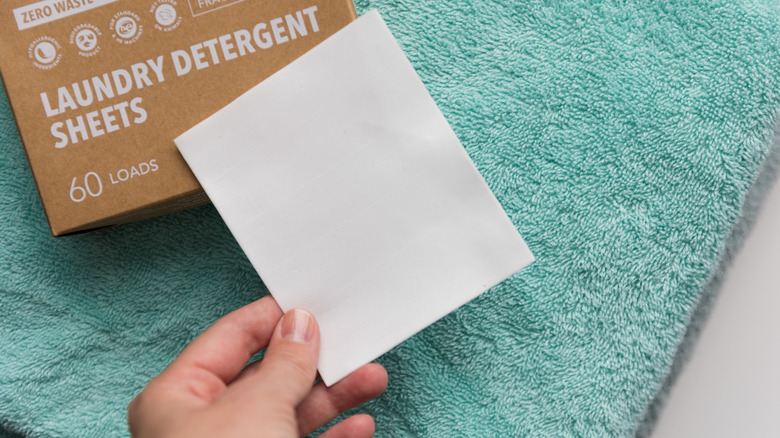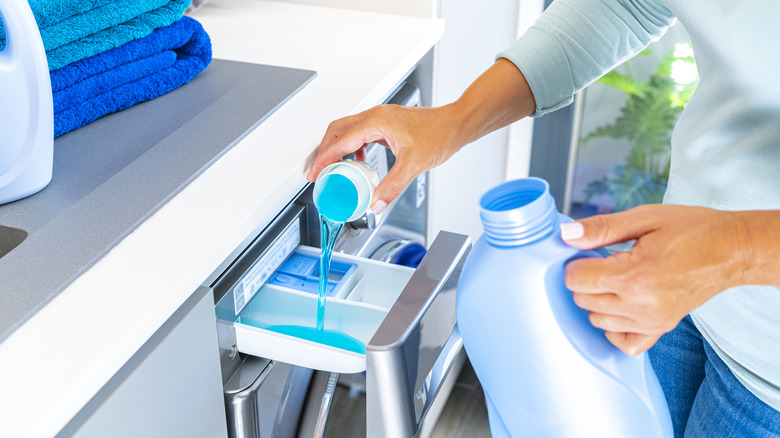The Hidden Downsides Of Using Laundry Detergent Sheets
Detergent sheets have emerged as an alternative to traditional laundry detergent for several compelling reasons. Crucially, detergent sheets are more convenient and mess-free. They come as thin, pre-measured, easily dissolvable sheets, eliminating the need for measuring and the risk of spillage. Detergent sheets also appear to be more environmentally friendly because they're sold in smaller packages compared to the bulky, plastic liquid detergent bottles. Further reducing their carbon footprint is their compact form, which generally requires less water for production and less fuel for transportation. But while these sheets certainly occupy less space and are easier to handle, they come with a few drawbacks that are not obvious to the average consumer.
For one, detergent sheets aren't as effective on tough stains as as their liquid counterparts, and heavily soiled clothes may not be as clean as you want them at the end of a laundry cycle. They may even leave clothing with stains that irritate your skin. And despite the lighter packaging, these sheets still release plastics into our waterways because they can't be fully removed by wastewater treatment facilities.
Detergent sheets are less effective at washing clothes
There's one detergent sheet downside you may not notice until you have a heavily soiled item on your hands. Based on the results of a test by Consumer Reports, compared to liquid detergents, detergent sheets from various brands performed poorly when used to clean blood, coffee, chocolate, grass, and other stubborn stains. Their ability to remove coffee stains was notably dismal, although the enzymes present in liquid detergent also made quicker work of protein stains, like those caused by grass and blood. Interestingly enough, a similar test by New York Times Wirecutter found that detergent sheets performed their worst in the eco-friendly cold-water cycles, doing only a slightly better job than water alone.
Another issue users have reported with some detergent sheets is leftover residue. This flaw may remind you of days past, when powder detergent was the dominant laundry cleaning agent, and residual stains would often appear on clothes. Like powder, detergent sheets don't dissolve or wash away as easily in water as the liquid stuff does. And while not all brands have this issue, if you're using the sheets, there's a good chance that you may notice detergent residue — especially on your dark garments. Not only do these detergent stains make your clothes look worn and old, but the toxins they contain can also irritate your skin and even disrupt your body's hormonal balance.
Ecological drawbacks of using laundry detergent sheets
Compared to other laundry products, detergent sheets have one clear edge in eco-friendliness. Their packaging is often made of cardboard, and even when it's plastic, it's still thinner and lighter than the giant liquid detergent bottles, so opting for these sheets means using and recycling less plastic. That said, other alleged ecological benefits of these sheets are up for debate. Worse yet, the sheets might actually contribute to water pollution, much like detergent pods.
For one, detergent sheets are often touted as eco friendly because their composition requires less water, while their light weight translates into less fuel burned during transportation. But water is still used to make the sheets — in fact, it comprises as much as 40% of the mixture needed to create them in some cases. Also, shipping the sheets from domestic producers may lead to less fuel use vis-à-vis the bulkier liquid detergent bottles, but a good number of brands manufacture the sheets in China. Finally, since cold cycles lead to poorer cleaning performance, you may be forced to use warm water to wash laundry and consume more power as a result.
Another hidden drawback to using detergent sheets is their polyvinyl alcohol (PVA) content. PVA is a type of plastic used to manufacture plastic-covered dish pods and laundry detergent pods. According to a study published in the International Journal of Environmental Research and Public Health (via MDPI), these plastics, albeit dissolved in water, find their way into the environment despite going through water treatment facilities. Their effect is unknown, but the authors of the study consider the presence of PVAs in the environment a threat to ecosystems.


